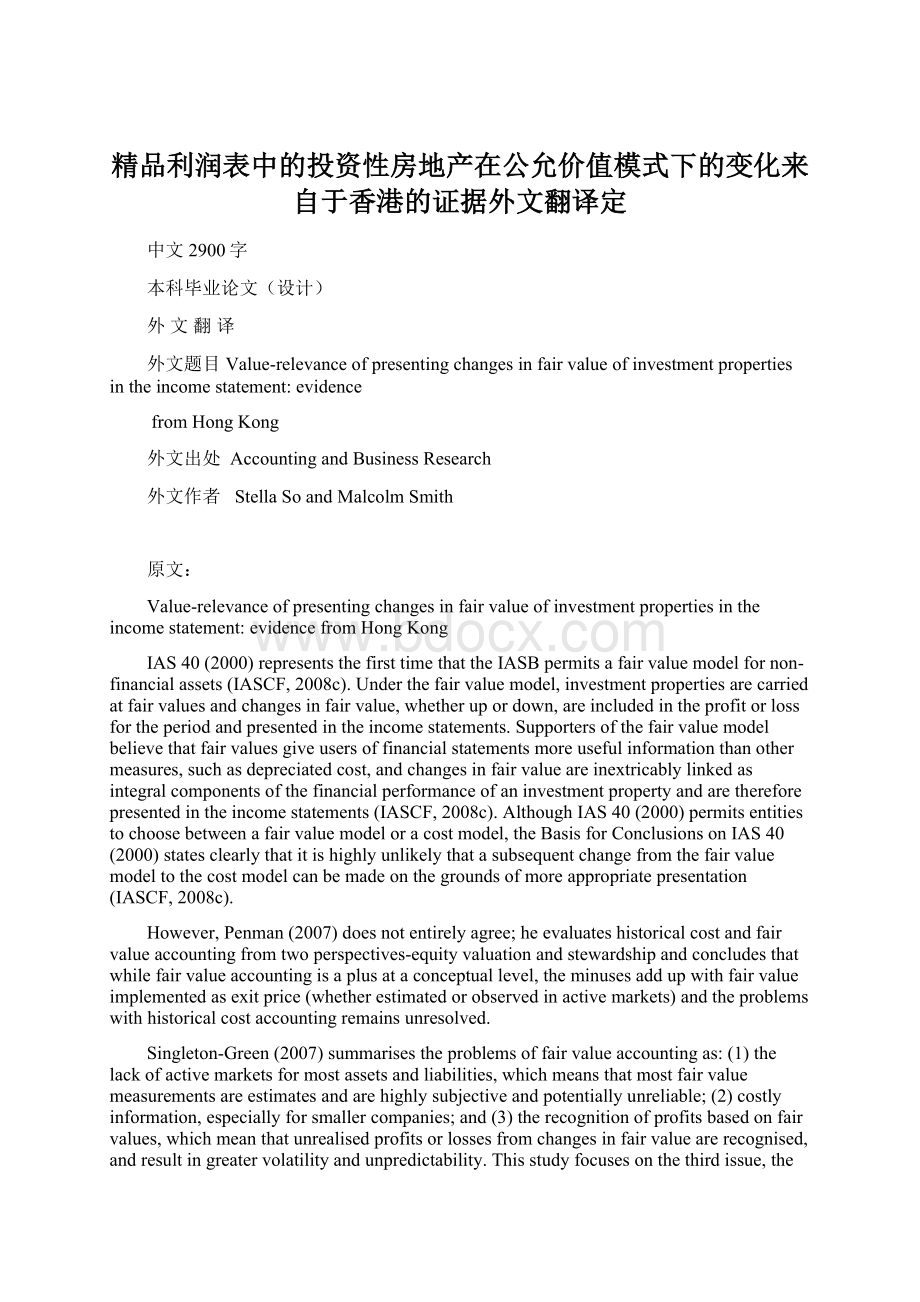精品利润表中的投资性房地产在公允价值模式下的变化来自于香港的证据外文翻译定.docx
《精品利润表中的投资性房地产在公允价值模式下的变化来自于香港的证据外文翻译定.docx》由会员分享,可在线阅读,更多相关《精品利润表中的投资性房地产在公允价值模式下的变化来自于香港的证据外文翻译定.docx(7页珍藏版)》请在冰豆网上搜索。

精品利润表中的投资性房地产在公允价值模式下的变化来自于香港的证据外文翻译定
中文2900字
本科毕业论文(设计)
外文翻译
外文题目Value-relevanceofpresentingchangesinfairvalueofinvestmentpropertiesintheincomestatement:
evidence
fromHongKong
外文出处AccountingandBusinessResearch
外文作者StellaSoandMalcolmSmith
原文:
Value-relevanceofpresentingchangesinfairvalueofinvestmentpropertiesintheincomestatement:
evidencefromHongKong
IAS40(2000)representsthefirsttimethattheIASBpermitsafairvaluemodelfornon-financialassets(IASCF,2008c).Underthefairvaluemodel,investmentpropertiesarecarriedatfairvaluesandchangesinfairvalue,whetherupordown,areincludedintheprofitorlossfortheperiodandpresentedintheincomestatements.Supportersofthefairvaluemodelbelievethatfairvaluesgiveusersoffinancialstatementsmoreusefulinformationthanothermeasures,suchasdepreciatedcost,andchangesinfairvalueareinextricablylinkedasintegralcomponentsofthefinancialperformanceofaninvestmentpropertyandarethereforepresentedintheincomestatements(IASCF,2008c).AlthoughIAS40(2000)permitsentitiestochoosebetweenafairvaluemodeloracostmodel,theBasisforConclusionsonIAS40(2000)statesclearlythatitishighlyunlikelythatasubsequentchangefromthefairvaluemodeltothecostmodelcanbemadeonthegroundsofmoreappropriatepresentation(IASCF,2008c).
However,Penman(2007)doesnotentirelyagree;heevaluateshistoricalcostandfairvalueaccountingfromtwoperspectives-equityvaluationandstewardshipandconcludesthatwhilefairvalueaccountingisaplusataconceptuallevel,theminusesaddupwithfairvalueimplementedasexitprice(whetherestimatedorobservedinactivemarkets)andtheproblemswithhistoricalcostaccountingremainsunresolved.
Singleton-Green(2007)summarisestheproblemsoffairvalueaccountingas:
(1)thelackofactivemarketsformostassetsandliabilities,whichmeansthatmostfairvaluemeasurementsareestimatesandarehighlysubjectiveandpotentiallyunreliable;
(2)costlyinformation,especiallyforsmallercompanies;and(3)therecognitionofprofitsbasedonfairvalues,whichmeanthatunrealisedprofitsorlossesfromchangesinfairvaluearerecognised,andresultingreatervolatilityandunpredictability.Thisstudyfocusesonthethirdissue,thepresentationofchangesinfairvalueofinvestmentproperties,intheincomestatementversustherevaluationreserve.
Empiricalstudiesassessingtherelevanceandreliabilityoffairvalueaccountingversushistoricalcost-basedaccountingfocusonfinancialinstruments,andtheresultsfromthesestudiesaregenerallymixed.Barth(1994)findsthat,forasampleofUSbankswithdatafrom1971–1990,disclosedfairvalueestimatesofinvestmentsecuritiesprovidesignificantincrementalexplanatorypowerforbanksharepricesbeyondthatprovidedbyhistoriccosts.Fairvaluegainsandlossesofinvestmentsecurities(constructedfromtwoannuallydisclosedfairvalueestimates)are,however,foundtohavenosignificantincrementalexplanatorypowerforannualreturns(changesinshareprice),duetotheincreasedmeasurementerrors(Barth,1994).SimilarresultsareobtainedinBarthetal.(1995),Barthetal.(1996),Eccheretal.(1996)andNelson(1996),allusingbankdata.ResultsfromCarrolletal.(2003)differ;insteadofusingbankdata,theysampleclosed-endmutualfundswhichtypicallyhaveinvestmentsecurities(report-edatfairvalues)comprisingvirtuallyalltheirassetsandwithnegligibleliabilitiesandotherassets.Thisisanadvantagebecausethepotentialproblemintroducedbymeasuringsomeassetsandliabilitiesatfairvaluebutothersathistoricalcost,iseliminated.Significantassociationbetweensharepricesandthefairvalueofinvestmentsecurities,aswellasbetweensharereturnsandfairvaluesecuritiesgainsandlossesarefound.Toexaminewhetherdifferencesinthereliabilityofthefairvalueofinvestmentsecuritiesaffectinvestors’assessmentsoftheusefulnessoftheinformation,Carrolletal.(2003)examinetheassociationbetweensharepricesandfairvaluesacrossdifferentfundtypesandfindthatinallcases,includingthosetradedinthinmarkets,thereisasignificantassociationbetweenthesharepricesandfairvalues.
Incontrast,DanboltandRees(2008),usingUKdata,reportnosupportforfullfairvalueaccounting.Whilefairvalueincomeisconsiderablymorevalue-relevantthanhistoriccostincome,thehigherrelevancedisappearsinthepresenceofchangesinfairvalueaccountingbalancesheetvalues.DanboltandRees(2008)interprettheirresultsasevidenceoftheabsenceofanobviousadvantagefromadoptingfairvalueincomeaccountingiffairvaluebalancesheetvaluesareavailabletotheuser.
Value-relevanceresearchstudiestheassociationbetweenfairvalueestimatesandsharepricesorreturns.Sloan(1999)commentsthatwhilethisassociationprovidesevidencethatinvestorsfindfairvalueestimatestoberelevant,theinferencesregardingreliabilityareindirectandlimitedbythefactthatsharepricesreflectmanyfactorsotherthanthefairvalueestimates.Dietrichetal.(2001)subsequentlyuseadirectapproachtoinvestigatethereliabilityofmandatoryannualfairvalueappraisalestimatesbycharteredsurveyorsforUKinvestmentpropertiesandfindthatappraisalestimatesunderstateactualsellingpricesbutareconsiderablylessbiasedandmoreaccuratemeasuresofsellingpricethanrespectivehistoricalcosts.Dietrichetal.(2001)alsofindthatthereliabilityofappraisalestimatesincreaseswhenmonitoredbyexternalappraisersandBigSixauditors.
TheNewZealand(hereafterNZ)SSAPNo.17‘AccountingforInvestmentPropertiesandPropertiesIntendedforSale’(NZSA,1989)previouslyallowedNZcompaniesthechoiceofrecognisingunrealisedgainsorlosseseitherintheincomestatement,orasmovementsinaninvestmentpropertyrevaluationreserve,unlessthetotalofthereservewasinsufficienttocoveradeficit,inwhichcasetheamountofdeficitwastobechargedintheincomestatementaspartofoperatingresults.TheNZequivalentofIAS40cameintoeffecton1January2005,resultingintheeliminationofthechoiceofrecognisingunrealisedgainsintherevaluationreserve.Owusu-AnsahandYeoh(2006)investigatetherelativevalue-relevanceofthetwoalternativeaccountingtreatmentsforunrealisedgainsoninvestmentproperties,basedonasampleofNZcompaniesovertheperiod1990to1999,whenthechoicewasstillavailable.Theirresultsshowthatrecognitionofunrealisedgainsintheincomestatementisnotsuperiortorecognitionofunrealisedgainsintherevaluationreserveintermsoftheirvalue-relevance.However,Owusu-AnsahandYeoh(2006)includeonlycompanieswithpositivechangesinthevalueoftheirinvestmentproperties.
Takentogether,findingsfrompriorstudiesoffirmsintheUS,UKandAustraliancapitalmarketsduringthe1990ssuggestthatinvestorshavebeenprovidedwithfairvalueinformation(whetherrecognisedordisclosed)thatisgenerallyreliableandrelevant(whetherfairvalueestimatedbymanagementorindependentvaluer).Moreresearchshouldbeundertakentotestempiricallywhetherrelevanceandreliabilityimproveaftertheimplementationofthefairvaluestandardsonfinancialinstruments(e.g.IAS39)andwiththeextensionoffairvalueaccountingtonon-financialassets(i.e.IAS40).
LikeOwusu-AnsahandYeoh(2006),thisstudyexaminestheextensionoffairvalueaccountingtoinvestmentpropertiesandthepresentationoftheirfairvaluechangesintheincomestatements(ratherthanintherevaluationreserve)inparticular.UnlikeOwusu-AnsahandYeoh(2006),thisstudyemploysdatafromaccountingperiodswhentherelatedfairvalueaccountingstandardHKAS40isimplemented.Comparisonisthenmadewiththosefromtheimmediatepre-implementationaccountingperiodswhenSSAP13(2000)wasineffect.Also,unlikeOwusu-AnsahandYeoh(2006),thisstudyincludescompanieswithbothincreasesanddecreasesinfairvaluesandusesareturnmodeladaptedfromEastonandHarris(1991),Amiretal.(1993)andtheearningscapitalisationapproachfromBarth(1994).
Empiricalresults
AlthoughHKAS40(2004)allowsafreechoicebetweencostandfairvaluemodels,all92companiesintheinitialsamplechosetoadoptthefairvaluemodel.
Allthe92companiesareretainedfordataanalysis,withextremevariablevaluesverifiedagainsttheirsources.Sincenoproceduralerrorsorextraordinaryeventsareidentified,allthedatacollectedforthe92companiesareretainedforthesubsequentanalysis.
Eachcompanyisevaluatedtwice,intwoconsecutiveaccountingyearsbeforeandaftertheadoptionofHKAS40(2004).
Table1describesthedistributionofaccountingyear-ends,yearsoflast-timefollowingofSSAP13(2000)andyearsoffirst-timeadoptionofHKAS40(2004)forthe92companiesinthisstudy.
AppendixAdetailstheiridentities.MostcompanieshaveMarch31orDecember31accountingyear-ends,andadoptHKAS40(2004)forthefirsttimein2005or2006.WhileHKAS40(2004)mandatesadoptionforannualperiodsbeginningonorafter1January2005,17companieschoosetoadoptHKAS40(2004)early.13
Tables2Aand2Bcontaindescriptivestatisticsforthe92samplecompaniesinthestudyduringtheyear(s)whenHKAS40(2004)isadoptedforthefirsttimecomparedtotheyear(s)whenSSAP13(2000)isadoptedforthelasttime.
Onthewhole,whencompaniesapplyHKAS40(2004)forthefirsttime,theyareexperiencinghigherearningsandhighermarketvaluesandofferingtheirinvestorshigherabnormalreturns;thismaybeattribu